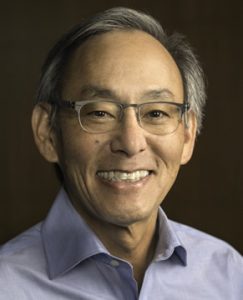Climate change and how we can shift to a sustainable future
 Steven Chu, William R. Kenan Jr. Professor and Professor of Molecular and Cellular Physiology,
Steven Chu, William R. Kenan Jr. Professor and Professor of Molecular and Cellular Physiology,
Stanford University
Friday, October 26, 2018
3:00 p.m., 32-123
Massachusetts Institute of Technology, Cambridge, MA
Steven Chu is the William R. Kenan, Jr., Professor of Physics and Professor of Molecular & Cellular Physiology in the Medical School at Stanford University. He has published over 280 papers in atomic physics, polymer physics, biophysics, biology, biomedical imaging, nanoparticle materials synthesis, batteries, and other energy technologies. He holds 10 patents, and has 11 more patent filings since 2015.
Dr. Chu was the 12th U.S. Secretary of Energy from January 2009 until the end of April 2013. As the first scientist to hold a Cabinet position and the longest serving Energy Secretary, he recruited outstanding scientists and engineers into the Department of Energy. He began several initiatives including ARPA-E (Advanced Research Projects Agency – Energy), the Energy Innovation Hubs, the annual Clean Energy Ministerial meetings in 2009, was personally tasked by President Obama to assist BP in stopping the Deepwater Horizon oil leak.
From 2004 – 2009, he was director of the Lawrence Berkeley National Laboratory, where he was active in pursuit of renewable and other forms of clean energy technologies. Previously, he was the Theodore and Francis Professor of Physics and Applied Physics at Stanford University. He was twice Chair of the Physics Department, helped launch Bio-X, a multi-disciplinary institute combining the physical and biological sciences with medicine and engineering, and the Kavli Institute for Particle Astrophysics and Cosmology. Before joining the Stanford faculty in 1987, he was head of the Quantum Electronics Research Department at AT&T Bell Laboratories.
Dr. Chu is the co-recipient of the 1997 Nobel Prize in Physics for his contributions to laser cooling and atom trapping, and has received numerous other awards. He is a member of the National Academy of Sciences, the American Philosophical Society, the American Academy of Arts and Sciences, the Academia Sinica, and is a foreign member of the Royal Society, the Royal Academy of Engineering, the Chinese Academy of Sciences, the Korean Academy of Sciences and Technology, and the National Academy of Sciences of Belarus. He received an A.B. degree in mathematics and a B.S. degree in physics from the University of Rochester, and a Ph.D. in physics from the University of California, Berkeley, as holds 32 honorary degrees.

